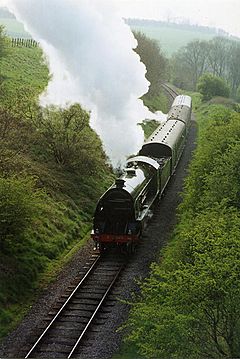Doulting Railway Cutting facts for kids
| Site of Special Scientific Interest | |
 |
|
| Area of Search | Somerset |
|---|---|
| Coordinates | 51°10′47″N 2°30′18″W / 51.17974°N 2.50496°W |
| Interest | Geological |
| Area | 2.8 hectares (0.028 km2; 0.011 sq mi) |
| Notification | 1971 |
Doulting Railway Cutting is a special place in Somerset, England. It's known as a Site of Special Scientific Interest (SSSI) because of its amazing geology. This means it's a protected area due to its important natural features, in this case, its rocks. The cutting covers about 2.8 hectares, which is like the size of almost seven football fields! It was officially recognized as an SSSI in 1971.
Contents
What Makes Doulting Railway Cutting Special?
This railway cutting is a fantastic outdoor classroom for anyone interested in rocks and Earth's history. It's a place where you can see layers of rock that tell a story millions of years old.
A Window into Earth's Past
The main reason Doulting Railway Cutting is so important is the rocks it shows. These rocks formed during the Middle Jurassic period. This was a time when dinosaurs roamed the Earth, about 174 to 163 million years ago!
Seeing Ancient Rock Layers
At Doulting, you can clearly see different rock layers. These layers include something called the Inferior Oolite and Great Oolite Junction. Oolite rocks are made of tiny, round grains that look like fish eggs. Geologists can also see the boundary between the Bajocian and Bathonian stages. These are specific time periods within the Middle Jurassic. Seeing these different layers helps scientists understand how the Earth changed over millions of years. It's like reading chapters in a very old book about our planet!
The Railway's Story
The cutting itself was not formed by nature. It was dug out by people in the 1850s to make way for the East Somerset Railway. This railway line is still active today! You can even see old steam trains chugging through the cutting, making it a cool mix of natural history and railway heritage.

